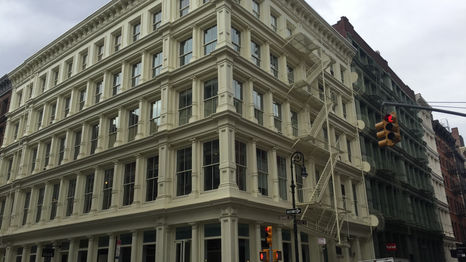
Soho
by Orchidée M.
Nous avons visité le quartier de Soho qui est devenu célèbre durant les années 1960-1970 et a été classé district historique en 1973 et figure sur le National Historic Landmark depuis 1978. Au niveau fédéral, il figure sur le Registre national des sites historiques :
We visited the district of Soho, which became famous during the 1960s and 1970. It was classified as a historical district in 1973 and it is a National Historic Landmark since 1978. At federal level, it is listed on the National Register of Historic Sites :
French version
Localisation
Le nom SoHo provient de South of Houston Street, mais n'a rien à voir avec le quartier de Soho à Londres. SoHo est bordé par :
-
Greenwich Village et NoHo au nord (North of Houston Street)
-
Little Italy à l'est
-
Chinatown au sud.
Evolution historique
Plusieurs anciens bâtiments industriels y ont été transformés en studios et en lofts. Dans les années 1990, Soho comptait plus de 300 galeries d'art et était célèbre pour ses créations contemporaines (graffitis, happening, photoréalisme, etc.). Puis le prix du mètre carré y augmente suite à l'accueil d’une nouvelle population, plus aisée et cela entraîne un exode des artistes vers des lieux plus abordables. On peut encore y trouver des galeries, mais surtout des boutiques de mode luxueuses. C'est devenu probablement un des quartiers de New York les plus touristiques.e 1954.
L'architecture
La fonte est utilisée au XIXe siècle pour les façades, les structures des usines et également pour les immeubles d'habitation. Grâce à la Révolution industrielle qui s’opère aux États-Unis à partir des années 1850, le coût de production de ces matériaux diminue et ils deviennent plus économiques que la pierre ou la brique. Ces bâtiments font l'objet de restaurations depuis les années 1970.
Parmi les bâtiments les plus remarquables de Soho il y a le E.V. Haughwout Building, le Cheney Building, le Gunther Building ou encore le Roosevelt Building. Ces immeubles comportent en général cinq à six étages. Leurs façades se caractérisent par de grandes baies vitrées et la présence d'escaliers extérieurs ajoutés au début du XXe siècle. Les éléments de décoration sont nombreux et empruntés à l'architecture classique européenne de styles Renaissance ou Second Empire : colonnes, arcades, corniche, balustrades, frises, etc...
English version
Localisation
The name SoHo comes from South of Houston Street, but has nothing to do with the district of Soho in London. SoHo is bordered by:
-
Greenwich Village and NoHo to the North(North of Houston Street)
-
Little Italy to the EastL
-
Chinatown to the south
Hisorical development
Several former industrial buildings were transformed into studio and lofts. In the 1990s, Soho have more than 300 art galleries and was famous for its contemporary creations (graffiti, happenings, photorealism, etc.). Later,when the district was inhabited by a new population, the price of property per square meter increased and that led to an exodus of the artists towards more accessible places. We can still find galleries there, but especially luxurious fashion shops. It has become probably one of the most touristy districts in New York.
Architecture
Cast Iron was used in the 19th century for facades and structures of factories but also residential buildings. Thanks to the industrial revolution that affected the United States from the 1850s, the cost of production of these materials decreased and became more economical than stone or bricks. They have been restored since the 1970s.
Among the most notable buildings in SoHo are E.V. Haughwout Building, Cheney Building, Gunther Building and Roosevelt Building. These buildings generally comprise five to six storeys. Their facades are characterized by large windows and the presence of external fire escapes added in the early twentieth century. The elements of decoration are numerous and borrowed from the European classical architecture of Renaissance or Second Empire styles: columns, arcades, cornices, balustrades, friezes, etc



